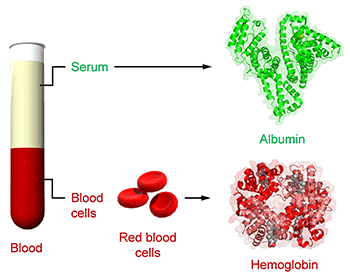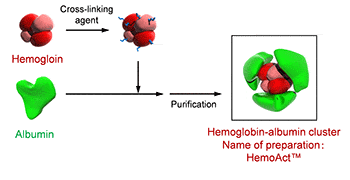Top>Research>Making artificial blood
 Index
Index

Teruyuki Komatsu [profile]
Education Course
Making artificial blood
Teruyuki Komatsu
Professor, Department of Applied Chemistry in the Faculty of Science and Engineering, Chuo University
Areas of Specialization: Chemistry and Biomaterials
Will we run out of blood?
Imagine that you are involved in an accident or disaster and lose a large amount of blood. You would need to get to a hospital immediately for a blood transfusion. Japan’s blood transfusion is one of the best in the world, so there is no need to worry. However, Japan is faced with serious problems which cannot be solved even with a high level of technology.
As you know, Japan is a country prone to natural disasters. When a major earthquake occurs, a large amount of blood is needed at once. However, it is not possible to store blood for a long period of time (the retention period for red blood cells is set at three weeks). One problem facing Japan is that there might not be sufficient blood for blood transfusion in the case of a major earthquake. Another problem is that the aging society and declining birthrate has resulted in a smaller number of young people, thus making it difficult to maintain a stable blood transfusion system. Currently, 85% of blood products for blood transfusions in Japan are used for patients aged fifty years or older. As the aging society and declining birthrate progresses in the future, the number of elderly people requiring blood transfusion will continue to increase while the population of blood donors (the younger generation) will decrease. In 2027, only twelve years from now, it is predicted that there will be a blood shortage of about one million people per year. The day may come when you cannot get a blood transfusion at a hospital. The predication is based on estimates by the Japanese Red Cross Society and has been published in official government bulletins. However, not many people are aware of the problem. At least, people are very surprised when they hear the numbers involved in the impending blood shortage.
Today, there is strong need for artificial blood which can be used anytime, anywhere and for any person regardless of blood type. This artificial blood is necessary as a primary measure for crisis management, as well as part of medical measures to supplement blood transfusion treatment. It bears repeating that this is not a problem faced by a developing nation without a blood transfusion system—it is a problem faced now by Japan. In this article, I will introduce new artificial blood developed at my laboratory.
History of artificial blood

Figure 1: Albumin and hemoglobin, the main constituents of blood
The creation of artificial blood has long been a dream of mankind. The history of artificial blood can be traced back many years. Toward the end of the 1970s, perfluorocarbon emulsion (a white liquid similar to milk) attracted attention as “white blood.” In the 1980s, researchers focused on modified hemoglobin preparations which used hemoglobin (Figure 1), a protein which transports oxygen that is inside of red blood cells. In the United States, clinical studies (test involving administration to people) for modified hemoglobin reached the final phase (Phase III), but side-effects (increased blood pressure) and efficacy issues ultimately prevented practical application. It is thought that the increase in blood pressure is the result of vasoconstriction caused when small hemoglobin leak from blood vessels. Normally, hemoglobin circulates through the body while contained in small bags inside of red blood cells, so there are functionality issues when administering hemoglobin alone. Several other types of preparations were developed, including artificial blood with nanocapsules containing hemoglobin. However, despite nearly fifty years of effort, no artificial blood has been approved for blood transfusion as of 2014.
HemoAct™: a new artificial blood
Albumin is a protein contained in large quantities in the serum which is a constituent of blood supernatant (Figure 1). Approximately five grams of albumin are dissolved in every 100 milliliters of serum in an adult male. Albumin fulfills the role of keeping blood inside of blood vessels, as well as transporting and storing metabolites and drugs. One day, I had the idea of creating a safe artificial oxygen carrier—in other words, artificial blood—by connecting albumin to the hemoglobin which carries oxygen.

Figure 2: Synthesis of (hemoglobin-albumin) cluster
After two years of conducting experiments both day and night with students in my laboratory, we finally succeeded in creating the desired molecule. Specifically, we created a core-shell (hemoglobin-albumin) cluster which connects three albumins around hemoglobin (Figure 2). The term “cluster” refers to how the hemoglobin and albumins are joined in shape like a bunch of grapes. We gave this preparation the name HemoAct™.
As the result of various experiments, we ascertained that three albumins are indeed connected to single hemoglobin. The next step was to verify that the proteins have a shape like that shown in Figure 2. Using an atomic force microscope which makes it possible to view single molecule, we succeeded in directly observing the triangular structure (Figure 3A). Furthermore, through special technology for replicating molecular structures based on electron micrograph, we clarified the three-dimensional structure of clusters (Figure 3B, C).

Figure 3: (Hemoglobin-albumin) cluster: (A) Micrograph of Atomic force microscope, (B) Electron micrograph, (C) Actual three-dimensional structure, (D) Glass bottle filled with red HemoAct™ preparation
Afterwards, we immediately formed a team including researchers from the pharmaceutical department and medical department in order to start assessment of HemoAct™ as an artificial blood. Since the surface of HemoAct™ is covered with albumin, the human body recognizes it as a safe substance. Upon actually administering HemoAct™ to a rat, it was retained in the blood for a long period of time and there were no side-effects. The size of HemoAct™ is only about eight nanometers (one nanometer is equal to one millionth of a millimeter), which is about one-thousandth of a red blood cell (eight micrometers). HemoAct™ can carry oxygen into clogged blood vessels, which gives it the possibility of being used as new medication for strokes. The only ingredients in HemoAct™ are hemoglobin, albumin and cross-linking agents (no expensive reagents are used), the manufacturing consists of just two steps, and no special equipment is required. I am often asked whether a shortage of blood will also result in shortage of the hemoglobin and albumin used to make HemoAct™. The answer to this question is “no.” It is possible to use hemoglobin from cows and pigs, while albumin can be made using recombinant DNA technologies. Therefore, there is absolutely no need to worry about a shortage of ingredients. HemoAct™ solution (Figure 3D) does not have a particular blood type and can be stored for long periods of time. It can also be stored as lyophilized powder. In other words, HemoAct™ is a new type of artificial blood which possesses none of the problems associated with current preparations.
Key resource in overcoming the crises of a blood shortage
The ideal state for medical institutions in the near future would be for artificial blood to always be kept available on shelves in a powder form or as a solution inside of plastic bags. In the case of an emergency, the required amount of artificial blood could be supplied to patients. I am sure that realizing this ideal state would be a significant contribution to improving the health and welfare of mankind.
Artificial blood has various uses in a wide range of fields. In addition to serving as a substitute for red blood cells (a resuscitation solution for patients in shock from loss of blood, a replenishing solution for patients who lost blood during operations, an oxygen-supply solution for use within emergency vehicles), it can be used as an oxygen-supply solution for ischemic regions due to heart failure, stroke or respiratory failure, a perfusate or storage solution for organs used in transplants, a replenishing solution for filling extracorporeal circulation such as heart-lung machines, a sensitizer for increasing the effect of cancer treatments, and an oxygen-supply solution for regenerated tissues and cells. It is also an invaluable resource in the field of veterinary medicine.
Imagine an artificial blood which can support concentrated need in the event of disaster, can be stored for long periods of time at room temperatures, is not associated with a particular blood type, has no risk of virus infection, and can be used anywhere, anytime and by anyone. The market for such an artificial blood would cover the entire world, including both advanced nations and developing nations. I hope that the development of artificial blood will be a key resource in overcoming the serious blood shortage crisis which Japan will face in the near future. With this goal in mind, I am conducting research at a rapid pace in order to realize the practical use of HemoAct™.
- Teruyuki Komatsu
Professor, Department of Applied Chemistry in the Faculty of Science and Engineering, Chuo University
Areas of Specialization: Chemistry and Biomaterials - Teruyuki Komatsu was born in Tokyo in 1966. He completed the Doctoral Program at the Waseda University Graduate School of Science and Engineering in 1994. He holds a PhD in engineering. In 1993, he was appointed as Research Fellow of the Japan Society for the Promotion of Science (JSPS). In 1995, he served as Postdoctoral Fellow of the JSPS for Research Abroad (Freie Universität, Berlin; Institute of Organic Chemistry). In 1997, he was appointed as Full-Time Instructor and then as Associate Professor at the Waseda University Advanced Research Institute for Science and Engineering (currently the Waseda Research Institute for Science and Engineering (RISE)). In 2006, he was appointed as Researcher at PRESTO Sakigake of the Japan Science and Technology Agency (concurrently held position). He assumed his current position in 2010.
His research themes include using proteins to develop new biomaterials for use in human health and medical care. He has published more than 140 original-papers. He holds various positions including Director of the Kanto Branch for The Chemical Society of Japan, Director of the Kanto Branch for The Society of Polymer Science, Japan, and Director of The Society of Blood Substitutes, Japan.
- Research Activities as a Member of Research Fellowship for Young Scientists (DC1), Japan Society for the Promotion of Science (JSPS) Shuma Tsurumi
- Important Factors for Innovation in Payment Services Nobuhiko Sugiura
- Beyond the Concepts of Fellow Citizens and Foreigners— To Achieve SDGs Goal 10 “Reduce Inequality Within and Among Countries” Rika Lee
- Diary of Struggles in Cambodia Fumie Fukuoka
- How Can We Measure Learning Ability?
—Analysis of a Competency Self-Assessment Questionnaire— Yu Saito / Yoko Neha - The Making of the Movie Kirakira Megane








